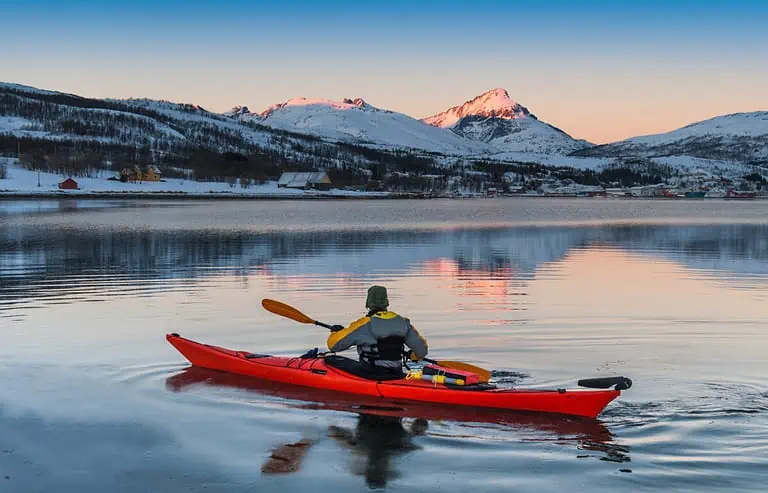Mastering Winter Kayaking: Essential Tips for Cold Water Adventures

Do you love kayaking and want to extend your paddling season into the winter months? If so, you’re not alone. Many kayakers enjoy the tranquility and beauty of winter kayaking, as well as the thrill of facing new challenges and conditions. However, winter kayaking is not for the faint of heart. It requires careful planning, preparation, and awareness of the risks involved. In this guide, we’ll cover everything you need to know to have a safe and fun winter kayaking adventure.
Understanding the Risks of Winter Kayaking
Winter kayaking is not without its dangers. Cold water can pose serious threats to your health and safety, especially if you’re not adequately prepared. Some of the most common risks associated with winter kayaking are:
Hypothermia: This is a condition where your body temperature drops below normal, affecting your vital organs and functions. Hypothermia can occur quickly in cold water, even if you’re wearing a drysuit. Symptoms include shivering, confusion, drowsiness, and loss of coordination. Hypothermia can be fatal if not treated promptly.
Cold shock: This is a physiological response to sudden exposure to cold water, which can cause involuntary gasping, increased heart rate, and loss of control over breathing. Cold shock can increase the risk of drowning, as well as trigger cardiac arrest in some cases.
Muscle impairment: Cold water can reduce your muscle strength and endurance, making it harder to paddle, balance, and perform self-rescue techniques. It can also affect your fine motor skills and reaction time, increasing the likelihood of accidents and injuries.
To avoid these risks, you need to be aware of the weather and water conditions before you go kayaking, and monitor them throughout your trip. Factors such as air and water temperature, wind speed, and current strength can affect your safety and comfort on the water. You also need to be realistic about your skills and abilities, and avoid paddling in situations that are beyond your level of experience. Always follow the safety rules and guidelines for winter kayaking, and never go alone.
Essential Gear for Winter Kayaking
One of the most important aspects of winter kayaking is having the right gear. The right gear can make a huge difference in your comfort and safety on the water, as well as your enjoyment of the experience. Some of the essential gear items for winter kayaking are:
Drysuit: This is a must-have for best winter kayaking, as it provides full-body protection from water and wind, while allowing perspiration to escape. A drysuit is made from waterproof and breathable materials, and has seals around the neck, wrists, and ankles to prevent water from entering. A drysuit also has insulation layers to keep you warm and comfortable. Look for a drysuit that fits well, has good mobility, and has features such as pockets, zippers, and vents for convenience and ventilation.
Layers: Underneath your drysuit, you need to wear layers of clothing that can help regulate your body temperature and keep you dry. The first layer should be a base layer made from synthetic or wool fabrics that can wick away moisture and prevent chafing. The second layer should be an insulating layer made from fleece or synthetic fill that can trap heat and provide warmth. The third layer should be an optional outer layer that can add extra protection and wind resistance. Avoid cotton, as it absorbs moisture and can cause heat loss and discomfort.
Accessories: To protect your extremities from the cold, you need to wear gloves, booties, and a hat or hood. Gloves and booties should be made from neoprene, which is a material that provides insulation and flexibility. They should also have good grip and fit snugly to prevent water from entering. A hat or hood should be made from neoprene or fleece, and should cover your head and ears to prevent heat loss and frostbite. You may also want to wear a helmet for extra protection, especially if you’re paddling in rough or rocky waters.
Footwear: Besides booties, you also need to wear shoes that can provide stability and traction on slippery or icy surfaces. Shoes should be waterproof, durable, and have good tread. You may also want to wear gaiters to prevent snow or water from getting into your shoes.
By wearing the right gear, you can ensure that you’re prepared for any weather or water conditions, and that you can stay warm, dry, and safe on the water.
Preparing Your Kayak for Cold Weather
Another important step for winter kayaking is preparing your kayak for the cold weather conditions. A well-prepared kayak can improve your performance and safety on the water, as well as prevent damage or malfunction. Some of the things you need to do to prepare your kayak for winter kayaking are:
Check your kayak: Before you go kayaking, you need to inspect your kayak for any cracks, leaks, or defects that could compromise its integrity or function. You also need to check your hatch covers, bulkheads, and deck lines for any signs of wear or damage. If you find any issues, you need to repair them or replace them as soon as possible.
Clean your kayak: After each kayaking trip, you need to clean your kayak thoroughly to remove any dirt, salt, or debris that could cause corrosion or deterioration. You also need to dry your kayak completely to prevent mold or mildew from forming. You can use a sponge, a cloth, or a hose to clean your kayak, and a towel or a fan to dry it. You may also want to apply a protective spray or wax to your kayak to enhance its durability and appearance.
Store your kayak: When you’re not using your kayak, you need to store it properly to protect it from the elements and potential damage. You should store your kayak in a cool, dry, and shaded place, away from direct sunlight, heat, or moisture. You should also store your kayak upside down or on its side, supported by racks or straps, to prevent deformation or warping. You should avoid storing your kayak on the ground, as it could attract pests or rodents that could chew or scratch your kayak.
By taking good care of your kayak, you can ensure that it’s ready for your next winter kayaking adventure, and that it lasts for a long time.
How to Prepare Your Kayak for Winter Paddling
Kayaking in cold water can be a thrilling and rewarding experience, but it also requires some extra preparation and precautions. In this post, we’ll share some tips on how to get your kayak ready for the winter season, as well as some safety advice and techniques for cold water paddling.
Insulate Your Kayak and Gear
One of the first things you need to do is to insulate your kayak against the cold. This will help you stay warm and comfortable while paddling, and also prevent cold air from entering the kayak. You can use foam insulation or padding to cover the cockpit and bulkheads, and also line the inside of your kayak with closed-cell foam or bubble wrap. These materials will create an extra layer of protection against the cold and also reduce condensation.
You also need to protect your gear from freezing and getting wet. Use waterproof dry bags or containers to store your gear and keep it dry and secure. If you have electronics or other sensitive items, use a dry box or case to shield them from water and temperature changes. Make sure your gear is easily accessible and attached to your PFD or kayak.
Check Your Kayak’s Condition
Before you hit the water, you need to make sure your kayak is in good shape and ready for the cold. Look for any signs of damage or wear and tear, and fix them as soon as possible. Check your kayak’s hull, deck, and seams for any cracks, holes, or leaks, and use sealants or patches to repair them. You don’t want to risk your kayak sinking or taking on water in the cold.
You also need to store and transport your kayak properly to prevent damage and extend its life. Keep your kayak indoors or in a sheltered area away from extreme temperatures and sunlight. When you move your kayak, use padded straps or racks to secure it to your vehicle and avoid it from moving or falling.
Follow Safety Protocols
Kayaking in cold water can be dangerous if you’re not prepared and careful. You need to follow some safety protocols to reduce the risks and ensure a safe and fun paddling experience. Here are some of the most important safety tips for cold water kayaking:
Wear a PFD at all times: A PFD can save your life if you capsize or have an emergency. Choose a PFD that fits you well and has enough buoyancy for paddling.
Dress for the water, not the air: Wear layers and cold weather gear, even if the air feels warm. Water can take heat away from your body much faster than air, so you need to stay warm and dry.
Practice self-rescue techniques: Learn how to do self-rescue maneuvers such as the paddle float rescue, T-rescue, and Eskimo roll. Practice them regularly in a safe environment before trying them in cold water.
Paddle with a buddy: Paddle with a partner or group, and stay close and visible to each other. A buddy can help you in case of an emergency or trouble.
Carry essential safety equipment: Bring a marine radio, whistle, signaling mirror, and other emergency items in a waterproof dry bag attached to your PFD or kayak. These items can help you call for help and communicate with rescuers if needed.
Know your limits: Be honest with yourself about your skills and experience, and don’t paddle in conditions that are beyond your abilities. If the weather or water gets worse or you feel uneasy, turn back and head to shore.
By following these tips and guidelines, you can prepare your kayak for winter paddling and enjoy a safe and amazing paddling adventure.
How to Paddle Safely and Confidently in Cold Water
Winter kayaking can be a thrilling and rewarding experience, but it also requires proper preparation and technique to ensure your safety and comfort on the water. In this blog post, we will share some essential tips and techniques for cold water paddling, as well as some factors to consider when planning your winter kayaking adventure.
Tips and Techniques for Cold Water Paddling
Cold water paddling can pose some unique challenges and risks, such as hypothermia, frostbite, and reduced mobility. To avoid these dangers and enjoy your winter kayaking trip, you need to master some key techniques and skills. Here are some of them:
Keep a stable and balanced posture: Sit up straight in your kayak, with your knees slightly bent and your feet firmly on the footrests. Engage your core and keep your back straight to maintain balance and stability.
Hold the paddle with a relaxed grip: Don’t squeeze the paddle too hard, as this can cause muscle fatigue and discomfort. Instead, hold the paddle with a loose and relaxed grip, allowing for smooth and efficient strokes.
Use efficient stroke technique: Use your core and torso muscles to power your strokes, rather than relying on your arms. Rotate your torso and move your arms in sync to generate power and speed. This will help you conserve energy and avoid injury.
Brace for stability: Learn how to use your paddle to brace against the water and prevent capsizing in rough or choppy conditions. Practice different bracing techniques, such as the low brace and high brace, to keep your kayak stable and under control.
Edge your kayak: Learn how to tilt your kayak and improve your maneuverability in windy or turbulent conditions. Shift your weight to one side of the kayak and keep your paddle in the water to turn or steer your kayak.
Navigate icy waters with caution: Be careful when paddling in icy or slushy waters, as they can pose some hazards and obstacles. Avoid colliding with floating ice or debris, and keep a safe distance from ice formations. Be ready to change your course or adjust your technique as needed.
Stay alert and vigilant: Be aware of your surroundings and watch out for potential hazards, such as submerged objects, strong currents, or changing weather conditions. Keep your situational awareness high and be prepared to react quickly to any challenges.
By following these tips and techniques, you can improve your skills and confidence as a winter kayaker, and enjoy the beauty and excitement of cold water paddling.
Factors to Consider When Planning Your Winter Kayaking Adventure
Planning is crucial for a successful and enjoyable winter kayaking adventure. Before you hit the water, you need to consider some important factors and prepare accordingly. Here are some of them:
Choose suitable routes: Pick paddling routes that match your skill level and experience, and take into account factors such as distance, difficulty, and potential hazards. Do some research beforehand and get information about access points, water conditions, and points of interest along the way.
Consider daylight hours: Be mindful of the shorter daylight hours during the winter months and plan your paddling trips accordingly. Start early in the day to make the most of the available daylight, and plan to return to shore before sunset to avoid paddling in the dark.
Monitor weather forecasts: Stay updated on weather forecasts and conditions for your paddling area. Pay attention to factors such as temperature, wind speed, and precipitation, and be ready to adjust your plans based on the forecast. Avoid paddling in extreme weather conditions or when conditions are likely to worsen quickly.
By considering these factors and planning ahead, you can ensure your safety and comfort on the water, and make the most of your winter kayaking adventure.
How to Plan and Prepare for Winter Kayaking
Winter kayaking can be a thrilling and rewarding experience, but it also comes with unique challenges and risks. Cold water can pose serious threats to your health and safety, such as hypothermia, frostbite, and immersion shock. Therefore, it’s essential to plan and prepare carefully before embarking on a winter kayaking adventure. Here are some key steps to follow:
Check Permits and Regulations
Before you choose your paddling destination, make sure you research any permits or regulations that may apply to the area. Some waterways may have restrictions on access, usage, or seasonality. You may also need permits for parking or launching your kayak at certain locations. Obtain any necessary permits or permissions in advance to avoid any hassle or trouble on the day of your trip.
Inform Others of Your Plans
It’s always a good idea to let someone know where you are going and when you expect to return, especially when kayaking in cold water. Inform a friend or family member of your paddling plans, including your intended route, expected duration, and emergency contact information. This way, someone will know where to look for you and how to reach you if you don’t come back as planned.
Pack Essential Supplies
Packing a well-stocked paddling kit is crucial for any kayaking trip, but even more so for winter kayaking. You’ll need essential supplies such as food, water, navigation equipment, first aid kit, and emergency signaling devices. You should also bring extra clothing and gear to keep you warm and dry in case of unexpected changes in weather or conditions. For example, you may want to bring a dry suit, a thermal layer, a hat, gloves, and a waterproof bag.
Enjoy Cold Water Paddling Safely
By following these steps, you can plan and prepare for your winter kayaking adventure and minimize the risks involved. You can then enjoy the beauty and excitement of cold water paddling safely and confidently. However, you should also be prepared to handle any emergencies that may arise while kayaking in cold water. Here are some important steps to take in the event of an emergency:
Stay Calm and Assess the Situation
If an emergency occurs, the first thing to do is to stay calm and assess the situation rationally and objectively. Don’t panic or act impulsively, as this may worsen the situation. Take a moment to evaluate your surroundings, your own condition, and the condition of any other paddlers involved.
Signal for Help
If you are unable to resolve the emergency on your own, you’ll need to signal for help using appropriate signaling devices. These may include a whistle, a flashlight, or a signaling mirror. You can use these devices to attract attention by blowing a series of short blasts on your whistle or shining your flashlight in a repeated pattern.
Communicate Your Location
If possible, you should also use a marine radio or cell phone to call for assistance and communicate your location to emergency services or other nearby boaters. Provide as much detail as possible about your situation, such as your exact location, the nature of the emergency, and the number of people involved.
Execute Emergency Procedures
If necessary, you should also execute emergency procedures such as self-rescue maneuvers, buddy rescues, or group rescues. These are techniques that can help you get back into your kayak or assist another paddler in distress. You should practice these procedures regularly in a controlled environment so that you can perform them effectively and efficiently in a real-life emergency situation.
Administer First Aid
If anyone is injured or in need of medical attention, you should administer first aid to the best of your ability while waiting for professional help to arrive. Treat any injuries promptly and appropriately, and monitor the injured person’s condition closely until help arrives.
Stay Together
In the event of an emergency, it’s important to stay together as a group and support each other until help arrives. Avoid separating or leaving anyone behind, and work together to resolve the situation safely and efficiently.
How to Enjoy Winter Kayaking Safely and Comfortably
Winter kayaking is a thrilling and rewarding way to explore the natural beauty of cold water destinations. However, it also comes with its own challenges and dangers that require careful preparation and attention. In this blog post, we will share some tips and advice on how to stay safe and comfortable while paddling in cold water, as well as how to recover and reflect after your winter kayaking adventure.
Know the Risks and How to Manage Them
The main risk of winter kayaking is hypothermia, which is a condition where your body loses heat faster than it can produce it, resulting in a dangerously low body temperature. Hypothermia can impair your judgment, coordination, and consciousness, and can be fatal if not treated promptly. Hypothermia can occur even in mild water temperatures, and can be accelerated by factors such as wind, rain, sweat, and immersion.
To prevent hypothermia, you need to dress appropriately for the water temperature, not the air temperature. You should wear layers of synthetic or wool clothing that can keep you warm and dry, and avoid cotton or other materials that can absorb water and lose insulation. You should also wear a dry suit or a wetsuit that can protect you from water exposure and provide additional insulation. A dry suit is a waterproof garment that keeps you dry and allows you to wear layers underneath, while a wetsuit is a neoprene garment that traps a thin layer of water between your skin and the suit, which is then warmed by your body heat.
Another risk of winter kayaking is cold shock, which is a physiological response to sudden immersion in cold water. Cold shock can cause involuntary gasping, hyperventilation, increased heart rate and blood pressure, and loss of muscle control. Cold shock can impair your ability to swim, breathe, or perform self-rescue, and can increase the risk of drowning.
To prevent cold shock, you need to acclimatize yourself to the water temperature before you paddle. You can do this by splashing some water on your face and neck, or by immersing yourself gradually and calmly in the water. You should also wear a life jacket or a personal flotation device (PFD) that can keep you afloat and reduce the need for swimming. A life jacket or a PFD can also provide some insulation and protection from the wind.
Equip Yourself with the Right Gear and Safety Protocols
Besides dressing appropriately and wearing a life jacket or a PFD, you also need to equip yourself with the right gear and safety protocols to ensure a safe and enjoyable winter kayaking experience. Here are some essential items and practices that you should have and follow:
- A kayak that is suitable for the water conditions and your skill level. You should choose a kayak that is stable, maneuverable, and easy to handle in cold water. You should also check your kayak for any leaks, cracks, or damages before you paddle, and make sure it has adequate buoyancy and drainage.
- A paddle that is comfortable and efficient for your paddling style and technique. You should choose a paddle that is lightweight, durable, and ergonomic, and that matches your kayak size and shape. You should also have a spare paddle in case you lose or break your primary paddle.
A spray skirt that can seal the cockpit of your kayak and prevent water from entering. A spray skirt can also keep you warmer and drier, and allow you to perform rolls or braces without capsizing. You should choose a spray skirt that fits your kayak and your body snugly, and that has a quick-release mechanism for easy exit.
A bilge pump or a sponge that can remove water from your kayak in case of leakage or capsizing. A bilge pump is a device that can pump water out of your kayak, while a sponge is a simple tool that can absorb water and wring it out. You should keep your bilge pump or sponge within easy reach, and use them regularly to keep your kayak dry and light.
A whistle or a signal device that can alert others of your presence or distress. A whistle or a signal device can help you communicate with your fellow paddlers, or attract the attention of rescuers or bystanders in case of emergency. You should choose a whistle or a signal device that is loud, clear, and waterproof, and attach it to your life jacket or PFD.
A compass or a GPS that can help you navigate and orient yourself in the water. A compass or a GPS can help you find your way and avoid getting lost or disoriented in unfamiliar or changing water conditions. You should choose a compass or a GPS that is accurate, reliable, and waterproof, and mount it on your kayak or wrist.
A map or a chart that can show you the features and landmarks of the water area. A map or a chart can help you plan your route and identify potential hazards or points of interest in the water. You should choose a map or a chart that is detailed, updated, and waterproof, and keep it in a clear plastic bag or case.
A first aid kit that can treat minor injuries or illnesses that may occur during your paddle. A first aid kit can help you deal with cuts, scrapes, burns, blisters, insect bites, or hypothermia. You should choose a first aid kit that is compact, comprehensive, and waterproof, and keep it in a dry bag or container.
A dry bag or a waterproof container that can store your personal items and valuables. A dry bag or a waterproof container can protect your phone, wallet, keys, camera, or other items from water damage or loss. You should choose a dry bag or a waterproof container that is sturdy, spacious, and sealable, and attach it to your kayak or life jacket.
A buddy or a group that can paddle with you and provide support and assistance. A buddy or a group can make your winter kayaking experience more fun and safe, as you can share the joy and the challenge of paddling in cold water, and help each other in case of trouble. You should choose a buddy or a group that is compatible with your skill level and goals, and communicate and coordinate with them before, during, and after your paddle.
Master the Skills and Techniques of Cold Water Paddling
Besides equipping yourself with the right gear and safety protocols, you also need to master the skills and techniques of cold water paddling to ensure a safe and enjoyable winter kayaking experience. Here are some essential skills and techniques that you should learn and practice:
Paddling technique: You should paddle with a smooth, efficient, and powerful stroke that can propel you forward and steer you in the desired direction. You should use your whole body, not just your arms, to generate power and control, and maintain a good posture and balance in your kayak. You should also vary your paddling speed and cadence according to the water conditions and your energy level, and take breaks and rest when needed.
Bracing technique: You should brace with your paddle and your body to prevent or recover from capsizing. You should use your paddle as a support and leverage against the water, and use your body to lean into the direction of the tilt or the wave. You should also keep your head and eyes level with the horizon, and your hips and knees loose and flexible.
Rolling technique: You should roll with your paddle and your body to right yourself after capsizing. You should use your paddle as a pivot and a sweep against the water, and use your body to twist and snap your kayak upright. You should also keep your head and eyes down, and your arms and elbows close to your body.
Self-rescue technique: You should self-rescue with your paddle and your kayak to re-enter your kayak after capsizing. You should use your paddle as a stabilizer and a lever to lift yourself onto your kayak, and use your kayak as a platform and a slide to get back into your cockpit. You should also keep your body low and centered, and your legs and feet in the water.
Assisted-rescue technique: You should assist or be assisted by another paddler to re-enter your kayak after capsizing. You should use your paddle and your kayak as tools and aids to help or be helped by your buddy, and follow the instructions and signals of your buddy. You should also keep calm and cooperative, and thank your buddy after the rescue.
Plan and Prepare for Your Trips
Besides mastering the skills and techniques of cold water paddling, you also need to plan and prepare for your trips to ensure a safe and enjoyable winter kayaking experience. Here are some important steps and factors that you should consider and follow:
Check the weather and water conditions: You should check the weather and water conditions before you paddle, and choose a day and time that are suitable for your skill level and goals. You should avoid paddling in extreme or unpredictable weather or water conditions, such as strong winds, heavy rain, snow, fog, ice, or high waves. You should also check the tide and current information, and plan your route accordingly.
Choose a destination and a route: You should choose a destination and a route that are suitable for your skill level and goals. You should pick a destination and a route that are scenic, accessible, and safe, and that offer opportunities for exploration and adventure. You should also consider the distance and duration of your paddle, and the availability of facilities and services along the way.
Inform someone of your plans: You should inform someone of your plans before you paddle, and leave a note or a message with your destination, route, departure time, and expected return time. You should also check in with them when you start and finish your paddle, and let them know if you change your plans or encounter any problems. This way, they can alert the authorities or initiate a search and rescue operation if you do not return on time or contact them.
Conclusion
Winter kayaking is not for the faint of heart, but for those who are willing to face the challenge and the reward of paddling in cold water. Winter kayaking offers a unique and exhilarating way to experience the beauty and serenity of nature in colder months, as well as a chance to test and improve your skills and techniques. However, winter kayaking also comes with its own risks and dangers that require careful preparation and attention. By following the tips and advice in this blog post, you can enjoy winter kayaking safely and comfortably, and create unforgettable memories that will last a lifetime.
Remember to always prioritize safety and be prepared for emergencies, but don’t let fear hold you back from exploring new and exciting paddling destinations. With the right knowledge, skills, and mindset, you can embrace the challenge and the reward of winter kayaking, and discover a new dimension of paddling adventure.




